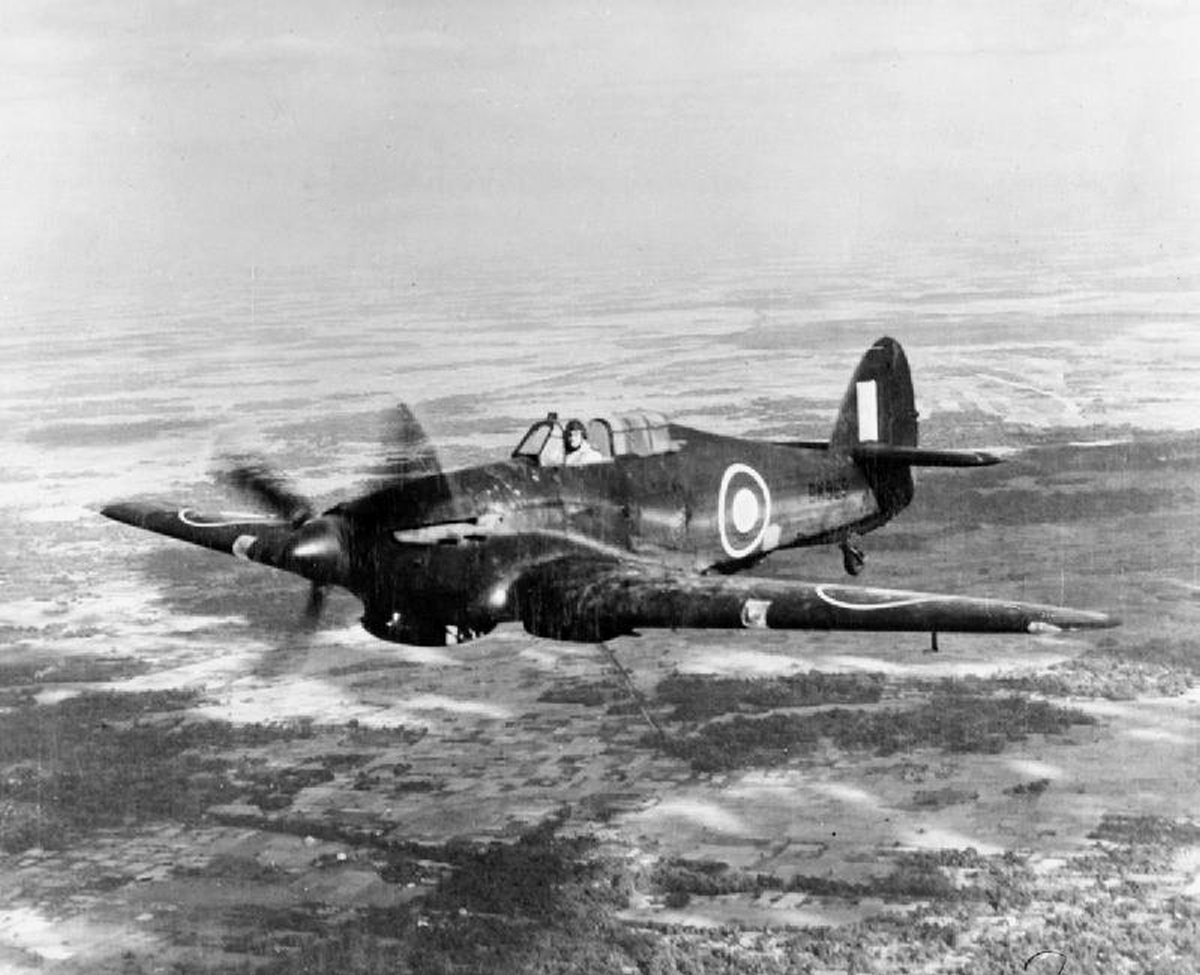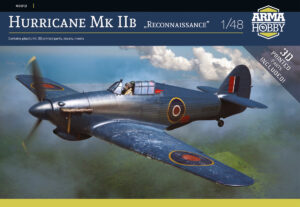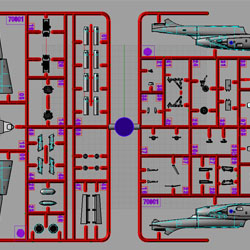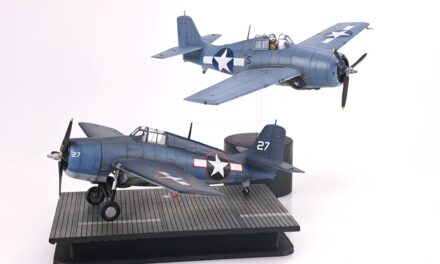
In the second half of 1942, Hurricane PR Mk II BM969 was assigned to No. 3 Photographic Reconnaissance Unit, or more precisely to its “S” Flight, where this letter stood for single-engined aircraft; the unit’s second flight operated twin-engined B-25s and was designated “T” for twin-engined.
At the time, the single-engined Hurricane and Spitfire reconnaissance section was commanded by Flight Lieutenant Donald Bertram Pearson. Popular photographs of our fighter show this very pilot at its controls. For his service with the unit, he was awarded the Distinguished Flying Cross (DFC) – obviously in recognition of the great importance of the tasks that reconnaissance aviation performed.

D. B. Pearson began his career as a Brewster Buffalo reconnaissance pilot soon after the breakout of hostilities with Japan. Prior to the Japanese attack, he had served for more than three years in the RAF in Malaya and knew the terrain excellently, a factor which predisposed him to such tasks. After the fall of Singapore, he was evacuated via Java and Ceylon to India, where a new reconnaissance unit, No. 5 PRU, soon to be renamed No. 3 PRU, was just being formed. On 26 May 1942, the squadron received its first photoreconnaissance Hurricanes, which had previously been operated by No. 2 PRU; they were flown in from Heliopolis in Egypt. Active duty began immediately, and F/Lt D. B. Pearson was already scouting the area of the town of Magway in Burma the following day on the unit’s operational début. The flight lasted 4 hours and 20 minutes.

Hurricane PR
Such a long trip was made possible by modifications implemented by the 103rd Maintenance Unit at RAF Station Aboukir, which included the fitting of fuel tanks in the emptied weaponry compartments. Two type F24 cameras were mounted in the fuselage, equipped with 14- or 20-inch focal length lenses. A pair of these cameras was installed in a doubled Mounting Type 34, thus allowing the placement of two apparatuses side-by-side in the Hurricane’s relatively narrow fuselage. The two vertical cameras were tilted away from each other in such a way that their fields of view overlapped by approximately 10%. The third camera could be installed obliquely or vertically, however it was not often used for typical missions. The F24 cameras took 5 x 5 inch photographs, and up to 250 images could be shot from a single type C cassette.

Staff of the photographic reconnaissance unit while operating the cameras. From left: two F24 cameras with 14-inch lenses for vertical shots, an F24 camera with a 14-inch lens for oblique shots, two F52 cameras with 20-inch lenses
Flying a photoreconnaissance Hurricane had nothing in common with flying a fighter – everything was completely different, even the stress that accompanied the pilots. Instead of a dynamic combat lasting a few minutes at most, pilots had to be ready for hours of solitary flight deep behind the front line, without radio contact, at 25,000 or even 30,000 feet.

Special camouflage
The camouflage was also completely different, in order to increase the chances of survival for aircraft that were armed only with cameras. In July 1941, the Air Ministry decided to exempt photoreconnaissance aircraft from the rules set for other aeroplane types, which constituted an acceptance of the informal practice – commenced already in early 1940 – of painting these aircraft in colours from outside the official palette, which were more suited to the specific conditions of high-altitude flight. Experiments conducted at No. 1 Photographic Reconnaissance Unit resulted in the expansion of the colour palette by PRU Blue, PRU Special Pink, and PRU Mauve – used for aircraft operating at low altitudes. Subsequent tests carried out at the Royal Aircraft Establishment (RAE) and the Aeroplane and Armament Experimental Establishment (A&AEE) by the High Altitude Development Flight led to the development of even better camouflage for high-flying aeroplanes through the use of very darks tones of ultramarine (Titanine Ultra Blue). The RAE recommended adopting this colour under the name Deep Sky.
The camouflage, however, did not catch on in the British Isles, and only later did No. 2 Photographic Reconnaissance Unit, stationed in Egypt, try out a similar paint scheme. Perhaps the previously used colours – Azure Blue, Light and Dark Mediterranean Blue – did not give a satisfactory effect against the background of the subtropical sky, and thus an even darker shade was applied. This was not exactly the same colour as Deep Sky, and perhaps still darker; it was known as Royal Blue, and was created by mixing a paint manufactured by Imperial Chemical Industries – Bosun Blue – with a black pigment in a proportion of 5:3 and a zinc powder, resulting in a deep matte that eliminated reflections of sunlight. When flying at an altitude of more than 14,000 feet, an aircraft painted in this scheme became almost invisible to observers on the ground. The aircraft were marked with RAF Type B cockades, which were composed of blue and red only, as it had been determined that white signage elements excessively increased visibility.

Hurricane PR Mk II, BM969, 3. Photographic Reconnaissance Unit (India) RAF, lotnisko Dum Dum, Bengal Zachodni, druga połowa 1942 r.
The first two photoreconnaissance Hurricanes painted in this camouflage were sent to the Far East already in January 1942. One of the significant problems that was encountered was that the blue colour of the identification marks blended with the camouflage, and the red circle then looked like the Japanese Hinomaru. On 21 March 1941, this contributed to the mistaken shooting down of one of the photoreconnaissance Hurricanes by a flier from No. 17 Squadron RAF, P/O Hedley Everard, who was flying a… Hurricane, of all aircraft; moments after destroying a Japanese fighter, he intercepted a Hurricane returning from a photoreconnaissance assignment, and, after firing off an accurate burst, forced it to belly-land. The victorious pilot later tried to excuse himself by stating that he had taken it for a Japanese Zero in the blue nautical paint scheme. As a result of the incident, yellow borders were applied around the identification marks on the wings to reduce the risk of successive errors. When No. 3 PRU was renamed No. 681 Squadron RAF in early January 1943, the painting of cockades on the fuselage was discontinued altogether, and the aircraft were marked with letters. Our BM969 was given the letter “Q”, and was still flying operationally in September 1943; unfortunately, however, we could not find any photograph from this period. At the time, the unit was also operating Spitfire PR IVs, but their number must have been too small to replace all of the worn-out Hurricanes, and so it was not until October 1943, following the arrival of Spitfire PR XIs, that these remarkable Hurricanes could finally be withdrawn from the front line.
Check also:
- Order reconnaissance Hurricane 1/48 model kit online at Armahobby store!
Model maker for 45 years, now rather a theoretician, collector and conceptual modeller. Brought up on Matchbox kits and reading "303 Squadron" book. An admirer of the works of Roy Huxley and Sydney Camm.
This post is also available in:
 polski
polski








A link to a thread on the origin and use of the blue colour on the box art, as well as what the colour possibly looks like.
https://www.britmodeller.com/forums/index.php?/topic/235146677-no2-pru-royal-blue-aka-bosun-blue-middle-and-far-east-pr-colour-seen-on-hurricanes-and-spitfires/
Excellent summary of knowledge with photos we can’t post here due to copyright reasons. Thank you Troy!